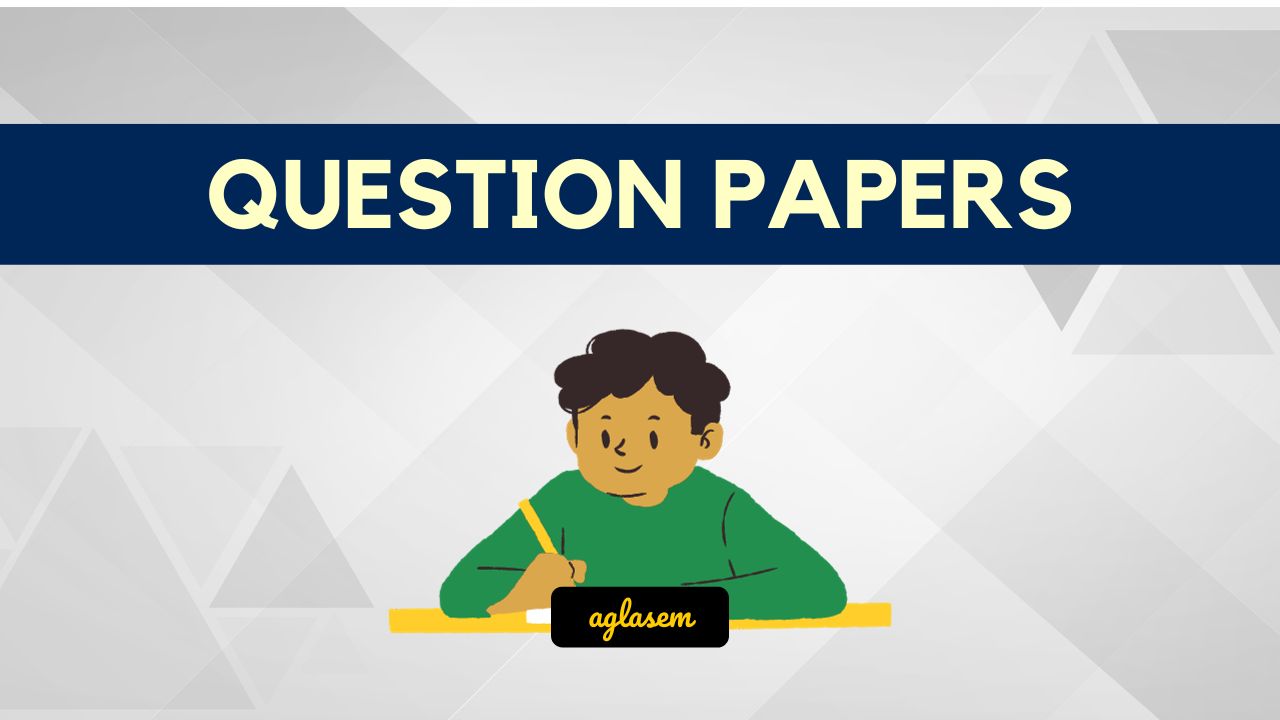Candidates can download NCERT Exemplar Class 12 Chemistry Chapter 12 from this page. The exemplar has been provided by the National Council of Educational Research & Training (NCERT) and the candidates can check it from below for free of cost. It contains objective, very short answer type, short answer type, and long answer type questions. Along with it, the answer for each question has also been provided. From the NCERT Exemplar Class 12 Chemistry Chapter 12, candidates can understand the level and type of questions that are asked in the exam.
NCERT Exemplar Class 12 Chemistry Chapter 12 Aldehydes, Ketones and Carboxylic Acids
NCERT Class 12 Chemistry Chapter 12 is for Aldehydes, Ketones and Carboxylic Acids. The type of questions that will be asked from NCERT Class 12 Chemistry Chapter 12 are displayed in the below provided NCERT Exemplar Class 12 Chemistry Chapter 12. With the help of it, candidates can prepare well for the examination.
Also Check: NCERT Solutions for Class 12 Chemistry
Multiple Choice Questions (Type-I)
- Addition of water to alkynes occurs in acidic medium and in the presence of Hg2+ ions as a catalyst. Which of the following products will be formed on addition of water to but-1-yne under these conditions.

- Which of the following compounds is most reactive towards nucleophilic addition reactions?

- The correct order of increasing acidic strength is _____________.
(i) Phenol < Ethanol < Chloroacetic acid < Acetic acid
(ii) Ethanol < Phenol < Chloroacetic acid < Acetic acid
(iii) Ethanol < Phenol < Acetic acid < Chloroacetic acid
(iv) Chloroacetic acid < Acetic acid < Phenol < Ethanol -

(i) Phenol and benzoic acid in the presence of NaOH
(ii) Phenol and benzoyl chloride in the presence of pyridine
(iii) Phenol and benzoyl chloride in the presence of ZnCl2
(iv) Phenol and benzaldehyde in the presence of palladium - The reagent which does not react with both, acetone and benzaldehyde.
(i) Sodium hydrogensulphite
(ii) Phenyl hydrazine
(iii) Fehling’s solution
(iv) Grignard reagent - Cannizzaro’s reaction is not given by _____________.
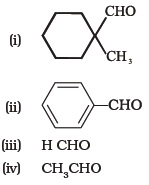

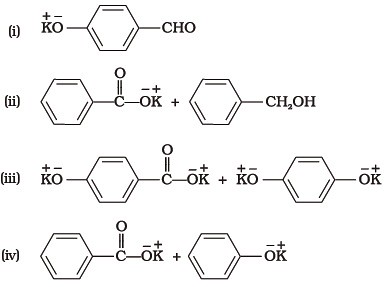

- Structure of ‘A’ and type of isomerism in the above reaction are respectively.
(i) Prop–1–en–2–ol, metamerism
(ii) Prop-1-en-1-ol, tautomerism
(iii) Prop-2-en-2-ol, geometrical isomerism
(iv) Prop-1-en-2-ol, tautomerism - Compounds A and C in the following reaction are __________.

(i) identical
(ii) positional isomers
(iii) functional isomers
(iv) optical isomers - Which is the most suitable reagent for the following conversion?

(i) Tollen’s reagent
(ii) Benzoyl peroxide
(iii) I2 and NaOH solution
(iv) Sn and NaOH solution - Which of the following compounds will give butanone on oxidation with alkaline KMnO4 solution?
(i) Butan-1-ol
(ii) Butan-2-ol
(iii) Both of these
(iv) None of these - In Clemmensen Reduction carbonyl compound is treated with _____________.
(i) Zinc amalgam + HCl
(ii) Sodium amalgam + HCl
(iii) Zinc amalgam + nitric acid
(iv) Sodium amalgam + HNO3
Multiple Choice Questions (Type-II)
Note : In the following questions two or more options may be correct.
- Which of the following compounds do not undergo aldol condensation?


(i) Phenol
(ii) Sodium phenoxide
(iii) Sodium benzoate
(iv) Benzophenone- Which of the following conversions can be carried out by Clemmensen Reduction?
(i) Benzaldehyde into benzyl alcohol
(ii) Cyclohexanone into cyclohexane
(iii) Benzoyl chloride into benzaldehyde
(iv) Benzophenone into diphenyl methane - Through which of the following reactions number of carbon atoms can be increased in the chain?
(i) Grignard reaction
(ii) Cannizaro’s reaction
(iii) Aldol condensation
(iv) HVZ reaction - Benzophenone can be obtained by ____________.
(i) Benzoyl chloride + Benzene + AlCl3
(ii) Benzoyl chloride + Diphenyl cadmium
(iii) Benzoyl chloride + Phenyl magnesium chloride
(iv) Benzene + Carbon monoxide + ZnCl2 
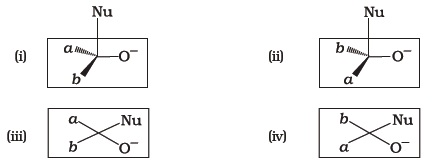
Short Answer Type Questions
- Why is there a large difference in the boiling points of butanal and butan-1-ol?
- Write a test to differentiate between pentan-2-one and pentan-3-one.
- Give the IUPAC names of the following compounds
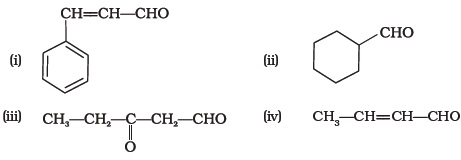
- Give the structure of the following compounds.
(i) 4-Nitro Propiophenone
(ii) 2-Hydroxy Cyclopentanecarbaldehyde
(iii) Phenyl acetaldehyde - Write IUPAC names of the following structures.

- Benzaldehyde can be obtained from benzal chloride. Write reactions for obtaining benzal chloride and then benzaldehyde from it.
- Name the electrophile produced in the reaction of benzene with benzoyl chloride in the presence of anhydrous AlCl3. Name the reaction also.
- Oxidation of ketones involves carbon-carbon bond cleavage. Name the products formed on oxidation of 2, 5-dimethylhexane-3-one.
- Arrange the following in decreasing order of their acidic strength and give reason for your answer.
CH3CH2OH, CH3COOH, ClCH2COOH, FCH2COOH, C6H5CH2COOH - What product will be formed on reaction of propanal with 2-methylpropanal in the presence of NaOH? What products will be formed? Write the name of the reaction also.
29. Compound ‘A’ was prepared by oxidation of compound ‘B’ with alkaline KMnO 4 . Compound ‘A’ on reduction with lithium aluminium hydride gets converted back to compound ‘B’. When compound ‘A’ is heated with compound B in the presence of H2SO4 it produces fruity smell of compound C to which family the compounds ‘A’, ‘B’ and ‘C’ belong to? - Arrange the following in decreasing order of their acidic strength. Give explanation for the arrangement.
C6H5COOH, FCH2COOH, NO2CH2COOH 
- Carboxylic acids contain carbonyl group but do not show the nucleophilic addition reaction like aldehydes or ketones. Why?
- Identify the compounds A, B and C in the following reaction

- Why are carboxylic acids more acidic than alcohols or phenols although all of them have hydrogen atom attached to a oxygen atom (—O—H)?
- Complete the following reaction sequence.

- Ethylbenzene is generally prepared by acetylation of benzene followed by reduction and not by direct alkylation. Think of a possible reason.
- Can Gattermann-Koch reaction be considered similar to Friedel Craft’s acylation? Discuss.
Matching Type Questions
Note : Match the items of Column I and Column II in the following questions.
- Match the common names given in Column I with the IUPAC names given in Column II.
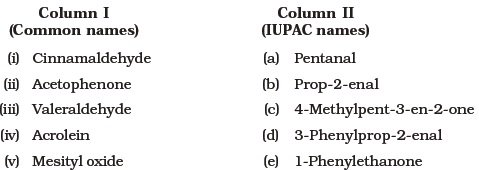
- Match the acids given in Column I with their correct IUPAC names given in Column II.
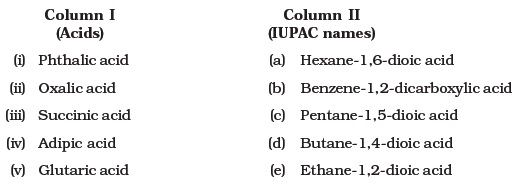
- Match the reactions given in Column I with the suitable reagents given in Column II.

- Match the example given in Column I with the name of the reaction in Column II.
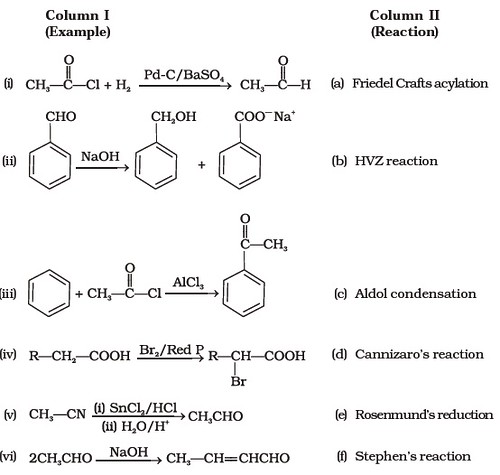
Assertion and Reason Type Questions
Note : In the following questions a statement of assertion followed by a statement of reason is given. Choose the correct answer out of the following choices.
(i) Assertion and reason both are correct and reason is correct explanation of assertion.
(ii) Assertion and reason both are wrong statements.
(iii) Assertion is correct statement but reason is wrong statement.
(iv) Assertion is wrong statement but reason is correct statement.
(v) Assertion and reason both are correct statements but reason is not correct explanation of assertion.
- Assertion : Formaldehyde is a planar molecule.
Reason : It contains sp2 hybridised carbon atom. - Assertion : Compounds containing —CHO group are easily oxidised to corresponding carboxylic acids.
Reason : Carboxylic acids can be reduced to alcohols by treatment with LiAlH4. - Assertion : The α-hydrogen atom in carbonyl compounds is less acidic.
Reason : The anion formed after the loss of α-hydrogen atom is resonance stabilised. - Assertion : Aromatic aldehydes and formaldehyde undergo Cannizzaro reaction.
Reason : Aromatic aldehydes are almost as reactive as formaldehyde. - Assertion : Aldehydes and ketones, both react with Tollen’s reagent to form silver mirror.
Reason : Both, aldehydes and ketones contain a carbonyl group.
Long Answer Type Questions
- An alkene ‘A’ (Mol. formula C5H10) on ozonolysis gives a mixture of two compounds ‘B’ and ‘C’. Compound ‘B’ gives positive Fehling’s test and also forms iodoform on treatment with I2 and NaOH. Compound ‘C’ does not give Fehling’s test but forms iodoform. Identify the compounds A, B and C. Write the reaction for ozonolysis and formation of iodoform from B and C.
- An aromatic compound ‘A’ (Molecular formula C8H8O) gives positive 2, 4-DNP test. It gives a yellow precipitate of compound ‘B’ on treatment with iodine and sodium hydroxide solution. Compound ‘A’ does not give Tollen’s or Fehling’s test. On drastic oxidation with potassium permanganate it forms a carboxylic acid ‘C’ (Molecular formula C7H6O2), which is also formed along with the yellow compound in the above reaction. Identify A, B and C and write all the reactions involved.
- Write down functional isomers of a carbonyl compound with molecular formula C3H6O. Which isomer will react faster with HCN and why? Explain the mechanism of the reaction also. Will the reaction lead to the completion with the conversion of whole reactant into product at reaction conditions? If a strong acid is added to the reaction mixture what will be the effect on concentration of the product and why?
- When liquid ‘A’ is treated with a freshly prepared ammoniacal silver nitrate solution, it gives bright silver mirror. The liquid forms a white crystalline solid on treatment with sodium hydrogensulphite. Liquid ‘B’ also forms a white crystalline solid with sodium hydrogensulphite but it does not give test with ammoniacal silver nitrate. Which of the two liquids is aldehyde? Write the chemical equations of these reactions also.
| « Previous | Next » |
Answers






Chemistry Physics Maths Biology
To get study material, exam alerts and news, join our Whatsapp Channel.
